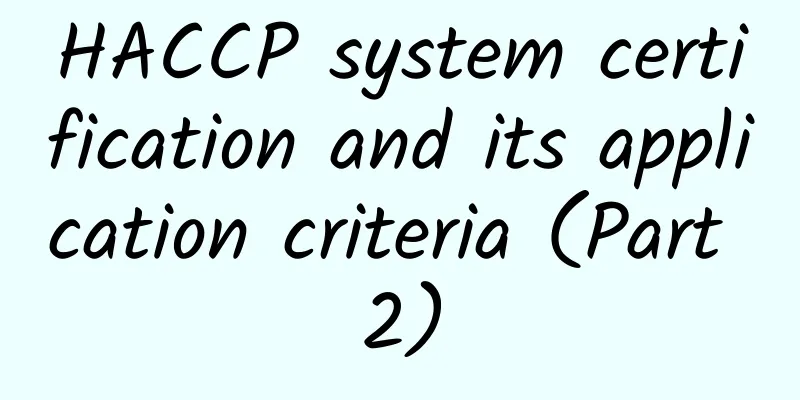HACCP system certification and its application criteria (Part 2)

|
HACCP system certification and its application criteria : 4. Good Manufacturing Practice (GMP) 1. The implementation of GMP for all types of food should be in accordance with published or referenced good manufacturing practices to determine whether the facilities, methods, operations and controls used to process the products are safe and whether these products are processed under sanitary conditions. 2. Enterprises should inspect and record the implementation of GMP and archive the records for future reference. 5. Sanitation Standard Operating Procedure (SSOP) 1. Each enterprise shall develop and implement a sanitation standard operating procedure or similar document to describe how the enterprise meets and implements the following sanitation conditions and specifications: (1) The sanitation and cleanliness of food contact surfaces (including equipment, gloves, and outer clothing); (2) the safety of water in contact with food or food surfaces or the safety of ice used in production; (3) Prevent unsanitary items from contaminating food, food packaging and other food contact surfaces, as well as cross-contamination between raw and cooked products; (4) Preventing food, food packaging materials and food contact surfaces from being contaminated with lubricants, fuels, pesticides, cleaners, disinfectants, condensing agents and other chemical, physical or biological contaminants; (5) The sanitation of restrooms, disinfection facilities and toilet facilities; (6) Standardized labeling, storage, and use of toxic compounds; (7) Eliminate rodents and insects in the factory. (8) Control of employee personal hygiene, which may result in microbial contamination of food, food packaging materials, and food contact surfaces. 2. Each company should inspect and record the implementation of SSOP, and archive the records for future reference. 6. Principles of HACCP The HACCP plan includes the following 7 principles: Principle 1: Identify critical control points (CCPs). Principle 2: Conduct a hazard analysis. Principle 3: Establish critical limits. Principle 4: Establish corrective actions to be taken when critical control points are lost. Principle 5: Establish a monitoring system to monitor the control status of each critical control point. Principle 6: Establish necessary procedures and records regarding the above principles and their application. Principle 7: Establish a verification procedure to confirm that the HACCP system is operating effectively. The above content is a supplement to the content about HACCP system certification and its application guidelines. If you want to know more about it, you can communicate with our factory inspection consulting experts through our online customer service or by phone. If you are not sure about passing the factory inspection or have unresolved factory inspection problems, you can go to Shanghai Chaowang for consultation. Welcome to call us! |
<<: HACCP system certification and its application criteria (I)
>>: The main differences between Wal-Mart factory inspection and THE HOME DEPOT factory inspection
Recommend
What is an export license? What is the scope of application of an export license?
What is an export license? In international trade...
Crowdfunder — Equity Crowdfunding Platform
What is Crowdfunder? Crowdfunder is another equit...
Ann Taylor_Ann Taylor Factory Inspection Self-Inspection Form
AnnTaylor_AnnTaylor Factory Inspection Factory Sel...
Warning signs required for BSCI factory audits - instructions for wearing protective clothing
Warning signs required for BSCI factory audit: si...
What are the rankings of Shenzhen cross-border e-commerce companies?
DX.com DX.COM Holdings (08086), a Hong Kong liste...
Is eBay easy to do business? Which one is more reliable, Amazon or eBay?
Is eBay easy to do business? To start with this q...
What are the main fees for eBay? Tips for sellers~
eBay divides the fees that sellers need to pay in...
How does eBay promote traffic? What are the methods?
For eBay sellers, after their stores are establis...
SCS Factory Inspection——Walmart Anti-Terrorism Factory Inspection Certification
Walmart's anti-terrorism factory inspection i...
To help export enterprises survive the cold wave of foreign trade, we offer free factory inspection training courses
The Canton Fair just ended, some were happy and s...
How is MaBang ERP? How much does it cost? Which platforms does MaBang ERP connect to?
How about MaBang ERP? Mabang ERP is the flagship ...
WALMART latest fire protection requirements
1. Each shift in the building shall conduct a joi...
BSCI Factory Audit Report Record Form - Chinese and English
Audit Assessment Part B BSCI Social Requirements ...
What is SVCOC Sustainable Viscose Certification?
Viscose (rayon) is a man-made cellulose fiber. Th...
How can individual Shopify sellers create their own peak season sales (Part 2)?
Shopify individual sellers' sales plan 1: sto...









